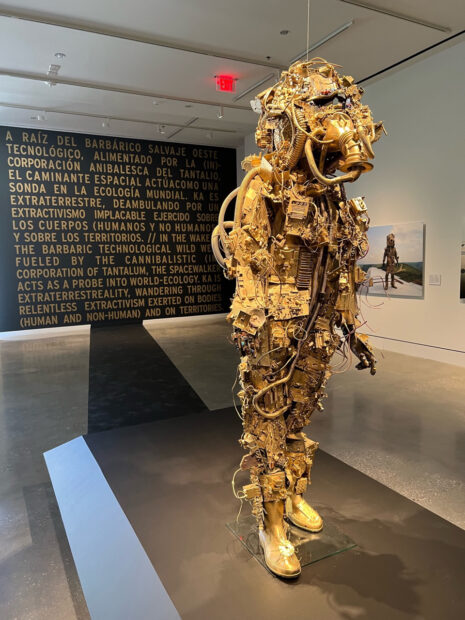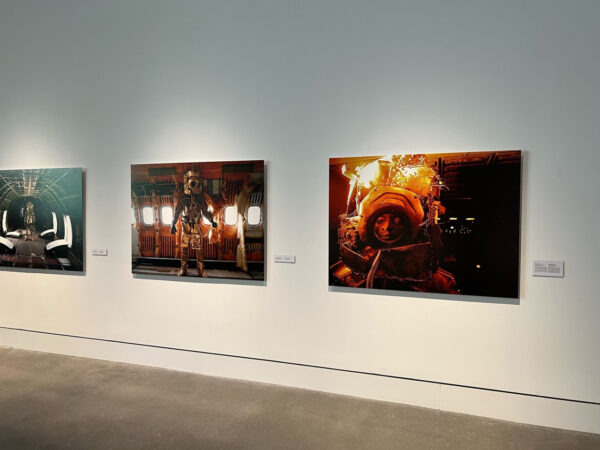
Installation view of “Congo Gravitational Waves // A Metadigital & Tantalean Tale,” on view at the College of Art and Design, University of North Texas, Denton
An ersatz space suit stands upright within the center of the flagship gallery at the University of North Texas’ College of Visual Arts. Glowing gold, the garment serves as both an art object and as an artifact of the fanciful activity conducted by the collective known as Kongo Astronauts. Founded by the Kinshasa duo Michel Ekeba and Eléonore Hellio, the group offers viewers a vision into a world that is imaginatively fictive yet grounded in ordinary experiences. Curated by Rachel Kabukala, the engrossing exhibition serves as a short introduction to an evocative group of artists.
As a member of the faculty at UNT since 2000 I have seen many memorable exhibitions on campus, but Kongo Astronauts’ show is startling in how simultaneously stunning and challenging the artwork feels. The vaguely post-apocalyptic Afrofuturist imagery elicits questions, but also seduces our senses with beauty, ingenuity, and dexterity of craft. The artifice employed by the collective smartly serves a complex underbelly of sociological and material meanings.

Installation view of “Congo Gravitational Waves // A Metadigital & Tantalean Tale,” on view at the College of Art and Design, University of North Texas, Denton
Entering the main gallery, one is confronted by the handcrafted spacesuit, as well as a series of slickly produced photographs that depict the artists wearing the golden-sprayed uniforms. The large-scale images are mostly scenes depicting a lone figure set within or near a scavenged jet airplane. The oddly surreal images feel like a cross between the hyper-cinematic works of Gregory Crewdson and the lo-fi immediacy one might find in cosplay, or the rough and tumble aesthetic of the science fiction film District 9. Importantly, each astronaut garment that is donned and paraded amongst the derelict jet is fashioned from disused computer parts.
Upon close inspection of the spacesuits, one gets lost in observing the tangle of old circuit boards and electronic detritus repurposed to create the skin of the wearable outfit. It should be noted that The Democratic Republic of the Congo is the major source for Coltan, which is processed into Tantalum and used to create capacitors for phones, computers, cameras etc. There is a historical and continued colonial presence in the Congo that the artists are critically highlighting through the reuse of these discarded parts.

Installation view of “Congo Gravitational Waves // A Metadigital & Tantalean Tale,” on view at the College of Art and Design, University of North Texas, Denton
Further complicating the purposefully seductive images is how the scenes represented evoke a feeling of longing for travel or escape to landscapes far afield. The invented astronaut clothing serves as an emblem of this desire. There is also meaning behind the title for the grouping of photographs; the collection is part of a series entitled After Schengen, referring to a treaty enacted in 1985. The background text about the exhibition states that the treaty “led to the establishment of unrestricted cross-national movement of European Union citizens within its borders and served to further complicate international travel for citizens of the Democratic Republic of the Congo and other African nations.”
This unfettered travel for EU citizens did not extend to those citizens living in the former European colonies. As such, one can read Ekeba’s and Hellio’s enactment of a spacewalker pacing about a derelict jet plane as both a strident protest of the massive mining and export of important natural resources, as well as the forced limitations of travel placed upon Congolese citizens. The overarching psychological feeling of the work seems to be a fervent call for greater political autonomy. Thus, the fiction of the golden astronaut becomes a poignant means to rebel against an unjustly restrictive predicament. It also feels like a grasping toward a greater power of self-possession. Because of the interior-minded fantasy present in the exhibition, one can’t also help but see a touch of Don Quixote in the wanderings of the Kongo Astronauts.
In Untitled (Facing the Past), 2019 these political and personal concerns become sharply defined. Inside a stripped jetliner, a space walker stands proudly as his suit shimmers. There is a sense of determination present in the forward gaze and body language of the artist, but there’s also an encompassing pathos exemplified by the nearly empty interior of the jet. An almost aching beauty is felt because of the creative use of what is commonly considered worthless rubbish — in this case to craft a uniform of power, prestige, and potency.
The wearing of the spacesuit seems to both reflect and transcend the mundane realities of existence within Kinshasa; it’s an emphatic act of rebellion. The Kongo Astronauts have described their work most eloquently as being built “…on the confrontation of experiences and is an attempt to resist the psychic ghettos that cover multiple postcolonial realities.” The work, therefore, serves as social resistance or a buffer against the myriad ways in which life is less than free. The fantasy envisioned in the exhibition serves as a kind of escape, but it also is a formidable psychological defense against undue and coercive governmental limitations.

Installation view of “Congo Gravitational Waves // A Metadigital & Tantalean Tale,” on view at the College of Art and Design, University of North Texas, Denton
In a small side room within the gallery, a short video entitled Postcolonial Dilemma #Track 3 (Unended) (2014-2017) plays on loop, quietly encapsulating the ethos of the Kongo Astronauts. A lone bucket-headed spacewalker is seen traveling along a mountain trail. He playfully brandishes what looks like a stick gun as he meanders up the footpath. The video is less outwardly sophisticated than the photographs, but in its roughness, it feels more direct. The astronaut wanders the path looking forward, yet he often pauses to awkwardly glance back down the route he traverses. The culmination of his walk is a rocky promontory that overlooks a massive waterfall. The figure spreads his arms in seeming communion with the power of the rushing water. Perhaps this simple gesture is meant to acknowledge that despite the political and social problems endemic to the Congo, there still exists a power inherent inside each individual and within the place that the Kongo Astronauts call home.
Congo Gravitational Waves // A Metadigital & Tantalean Tale is on view at the College of Visual Arts and Design Galleries at UNT through September 3, 2022.


